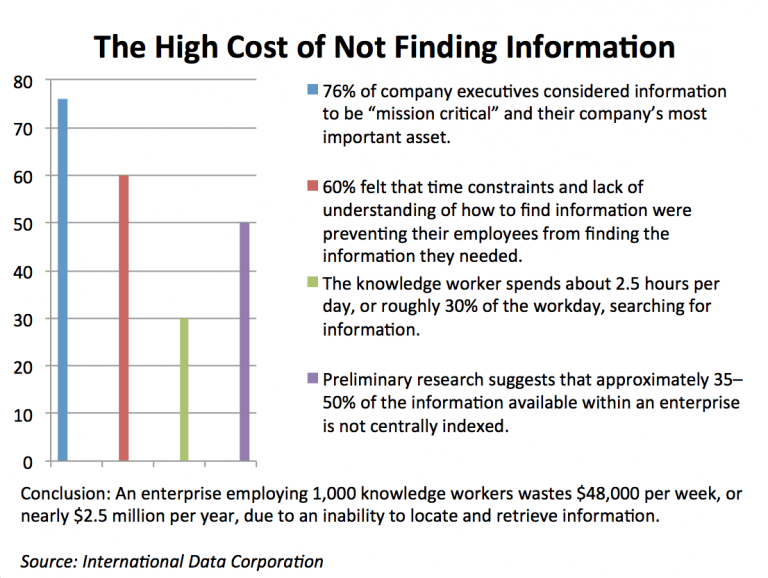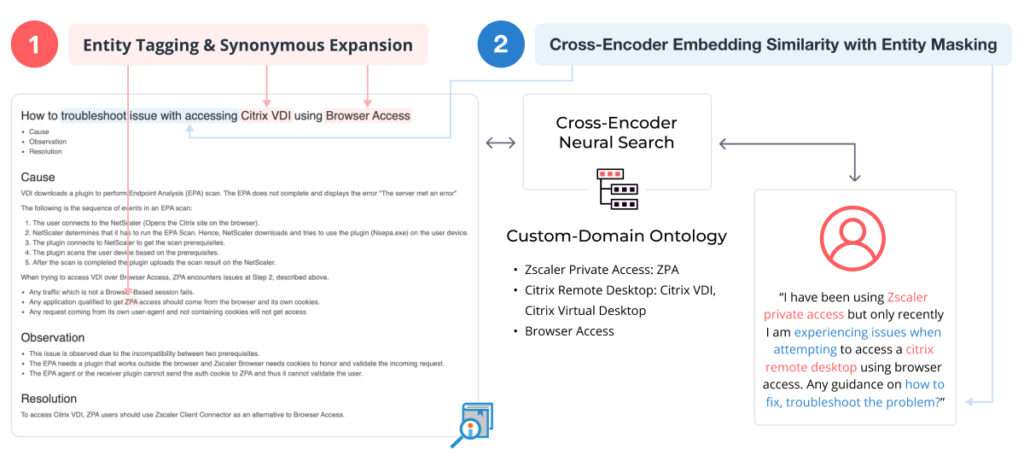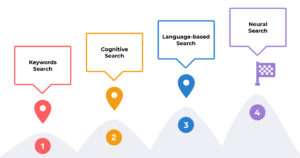What is Neural Search?
Neural Search is a step forward in finding information by leveraging artificial intelligence to create artificial neural networks. This type of machine learning model learns through training. Neural Search can select on the fly which content shall be rendered back to the user. For example, a whole document versus only a short text fragment to fulfill the user’s search journey.
Neural Search and Enterprise Search
Web-based search engines like Google, Bing, Yahoo, and DuckDuckGo have become synonymous with the concept of search in most of our minds.
However, enterprise search is another type of function. Though web-based search and enterprise search functionality are broadly comparable, they are quite different in their mechanics and serve distinctly varied purposes.
The intent of neural search software is to help these employees find the information they need. This may take the form of structured data (also called quantitative data) like dates, phone numbers, zip codes, customer names, product inventories, or transaction information; it resides in databases or spreadsheets.
Alternatively, employees may be seeking unstructured data (qualitative data) such as audio and video files, text or email files, social media files, PDFs, mobile data, and so forth. This type of data doesn’t fit nicely into spreadsheets or databases.
Enterprise software indexes and parses both types of data. Indexing is a technique of optimizing database performance for quick location and access. Data parsing converts one data string into another, such as taking raw HTML code and making it easily read and understood. The software then displays these comprehensible and relevant results to authorized users across the enterprise.
In 2017, Gartner formulated a new enterprise search category called “Insight Engines.” These solutions help businesses integrate information interactively, or even proactively, by ingesting, organizing, and analyzing data. Forrester, another renowned analyst firm, defines this new category as “Cognitive Search.”

Neural Search vs semantic Search
Neural Search is a form of semantic search and information retrieval that automates the design of artificial neural networks. As a machine learning model, Neural Search trains itself for increased accuracy and saves developers from having to hand-design every rule.
An enterprise AI search platform powered by neural search is far more accurate than a keyword search, as it takes into account the semantic context and relations between words, rather than just individual keywords. It can also work with multiple formats, including text, images, sound, and documents.
Finally, unlike traditional keyword-based methods, neural search employs vector search to represent words, sentences, or documents as high-dimensional vectors, capturing the semantic meaning and context more effectively.
The Evolution of Neural Search: From Keywords to Neural Intelligence
Keyword Search – Tokenizes the user query into tokens (single keywords) and searches the entire knowledge base (KB) spaces being indexed. Based on the number of tokens matched between the user query and KB and their position in the KB (Title, Subject, or Content) a score is assigned. The KBs are then stack-ranked based on those scores and rendered back to the user.
Benefit: The fact that users could self-serve by accessing information across knowledge bases by typing relevant search terms was a great start in this long journey of the evolution of search models.
Problem: When you search “How to connect to Teams,” it will match the right KB only if the KB contains keywords like ‘connect’, ‘connectivity’, ‘connecting.’ These are all lemmatized (grouped together according to different forms of the same word) by the search engine and Teams. This search system was quite basic and rudimentary.
Cognitive Search – Takes the predicates of a user query (a predicate is an expression that relates to a value of either true or false) and generalizes it with synonyms from destinations like dictionary.com or a similar source. It then understands negations and hence is capable of distinguishing between “how to connect” versus “cannot connect.” This increases the likelihood of a correct KB being served to the user.
Benefit: This was certainly a major leap ahead from Keyword Search. Cognitive Search could better correlate between synonyms as well as negative and positive keyword sentiments of the user’s search query.
Problem: Associations between “cannot connect to Teams” and a possible KB titled “Troubleshoot Session Timeouts in Teams” is not straightforward for Cognitive Search. Even though Cognitive Search uses negations to infer a more general predicate likely to be present in the KBs, so it can understand associations between “cannot connect” and “troubleshoot”, it struggles to semantically derive an association between “connect” and “session timeouts”.
Language-Based Model Search – These models fill the above limitation of the Cognitive Search (negation & predicate generalization with predicate association) and make the understanding of the user query even deeper. Language-Based Model Search is hence capable of deriving the association between “connection issue” and “session timeouts.” Conversely to Cognitive Search, Language-based models can precisely pinpoint the primary sentence from a long user query and focus on this when searching for answers. This is especially important when user queries tend to be long.
Benefit: Cognitive Search would fail as well for user queries like “I have installed Teams on my Mac. Since then, the app cannot connect any longer.” Language-based models are able to understand the semantic structure of the user query, identify the main and secondary phrases, extract the key entity (and references across phrases), and provide the right answer in most cases.
Problem: While Language-Based Model Search has greatly evolved to process and understand the user query, it still often fails to return relevant KBs. This is mostly due to the fact that it solely processes the user request and ignores the KB content apart from basic indexing and retrieval.
Neural Search. Neural Search is a Language-Based Model Search built on Deep Neural Networks (DNN). But Neural Search has something more—Cross-Encoders. While Language-Based Model Search primarily works only on the user-query side (does not analyze KBs at all during ingestion), Neural Search instead builds encodings for both the KBs (whole document, Title, Subjects, Paragraphs, and Phrases) and the user-query and uses a Cross-Encoder to score the similarities across Query and KB.
This is very powerful, as it leverages the deep learning and understanding of the KB space when processing real-time search results for the user’s query. Neural Search is capable of selecting on-the-fly which content shall be rendered back to the user (e.g., whole document versus only a short text fragment to fulfill the user’s search journey).
Future iterations of the neural search may utilize reinforcement learning to continuously improve search algorithms based on user interactions and feedback, enhancing the accuracy and relevance of search results over time.
Generative AI is also transforming how AI is leveraged across industries. In particular, generative AI in enterprise search generates contextually relevant responses or summaries, enriching the user experience. By combining neural search with generative AI techniques, search engines can not only retrieve the most relevant information but also generate new, insightful content or summaries from the search results. This synergy enhances the value of enterprise search by providing users with more accurate and tailored information, reducing the time needed to find critical insights.
How Does Neural Search Work?
According to the glossary of AI terms, Neural search leverages deep learning models to improve search results. Instead of relying solely on keyword matching, neural search understands context and semantics.
By converting text into numerical representations called embeddings, the model captures meaning and relationships between words. When a user submits a query, the system finds the closest embeddings in its database, ensuring results are contextually relevant.
This approach results in more accurate and intuitive search outcomes compared to traditional methods. In essence, neural search translates human language into machine language to deliver better search experiences. However, neural search systems often need to fine-tune their models on domain-specific data to improve accuracy and relevance, ensuring that search results are closely aligned with the specific needs of an enterprise.
Why is Neural Search Important?
Data is the cornerstone for a successful enterprise search experience. As an organization grows, there can be a concurrent rapid growth of product-oriented information, process-oriented information, marketing and sales-enablement content, and so forth. Multiple teams create content, which then inevitably spreads across the enterprise.
According to an Okta Study, enterprises with over 2,000 employees use an average of 175 SaaS applications, and this number is only growing exponentially year over year. Your neural search platform with knowledge management should be able to index all of these data sources to avoid knowledge silos slowing down your employees’ search efforts.
The content found inside large organizations tends to be highly fragmented, including Content Management Systems (CMS), Customer Relationship Management (CRM), Enterprise Resource Planning (ERP), data lakes, email databases, file systems, intranets, and social networks. Additionally, private and public cloud-based data reside in various repositories and enterprise applications.
Simple search solutions can work easily for smaller organizations with fewer data sources. But for enterprises with a high volume of documents and many fragmented systems, unified search with machine learning (ML) and NLP, NLU as well as NLG adds great value.
This is because these sophisticated language functions can automatically understand the context, meaning, and logic of interactions with content across your entire knowledge stack—even as you add new content and data sources. This results in superior and more accurate search relevance. That’s a huge win for both your employees and your IT teams, on a controlled budget.
In the real world, employees often need to search through vast amounts of both structured and unstructured data. Neural search provides a more intuitive and efficient way to find relevant information, regardless of the format.
How Neural Search Reinforces Productivity
Studies reveal the substantial cost of employee time expended in finding knowledge:
- According to an IDC study, the knowledge worker spends about 2.5 hours per day, or roughly 30% of the workday, searching for information.
- Interact reported that 19.8% of the business time – the equivalent of one day per working week – is wasted by employees searching for information to do their job effectively.
- Nearly 1 in 5 of the 1,000 U.S. office professionals surveyed ranked “digging for files they need” as the No. 1 problem to support the future of remote work; another 58% of the office pros said a quick search for files and documents is a “top-three problem.” according to a study by marketing research firm Wakefield Research.
Enterprise search software significantly reduces the time employees devote to finding the necessary information. As a result, it opens up work schedules for more high-value tasks on the job. This improvement is particularly important given the current emphasis on getting optimal performance out of teams in lean, digital, agile, and remote organizations.

Popular Use Cases of Neural Search
An enterprise search platform can address many different use cases in order to optimize employee productivity:
- Remote Workforce – Enabling remote teams to be more productive and collaborate effectively; it’s integral to the digital transformation agenda of many enterprises.
- Superior Customer Service – Empowering customer service reps with the ability to swiftly and easily find the information they need to deliver excellent customer service.
- Corporate Knowledge Management – Helping facilitate the corporate knowledge management process.
- Contact SMEs – Allowing employees to search for subject matter experts (SMEs) and filter results according to their expertise and knowledge across the enterprise.
- Talent Search – Matching applicants with job descriptions from a database of potential candidates.
- Intranet Search – Facilitating the ability of intranet users to locate needed information from shared drives and databases.
- Neural Search – Leveraging AI to detect relationships among people, content, and data, as well as connections between user interests and current and past search queries.
Conclusion: AI Search Solution
Most enterprises want to create a robust search experience by centralizing their knowledge and leveraging search as a service. If you can successfully apply enterprise search to this use case, you’ll reduce the time lag and inefficiencies of knowledge silos and information overload—empowering teams to do their best work.
To deliver a next-generation employee experience, making proactive content recommendations across the employee journey is valuable. This capability minimizes distractions and reinforces employee capabilities. It reveals an understanding of their daily workflow and how an artificial intelligence (AI) powered solution can supercharge it!
Imagine going a step further and bringing that unified enterprise search experience into the tools your employees use every day! With Aisera, this is an achievable pipe dream! Use Aisera’s AI Search for database search, enterprise system offloading, e-commerce, customer support, workplace content, websites, or any application to help everyone find what they need faster.
Boost team productivity with an intuitive search that scales across the enterprise and helps employees easily and securely locate information across all of your organization’s content sources: Salesforce, Microsoft SharePoint, Google Workspace, Atlassian Product Suite, Slack, Box, GitHub, and many more.
As Neural Search evolves information retrieval, its value is amplified when combined with Agentic AI. This synergy enables intelligent agents not only to retrieve relevant knowledge but also to act on it, resolve issues, initiate workflows, or guide users in real time. Together, Neural Search and Agentic AI unlock end-to-end automation across enterprise systems.
It’s more important than ever to have a long-term view of your technology and infrastructure to ensure that you can tackle the complexities of market shifts, market turbulence, mergers and acquisitions, and other critical global events that necessitate advanced knowledge management. Request a custom AI demo of Aisera’s Neural Search Solution to explore its innovative architecture and ability to kick-start your digital transformation journey today!

